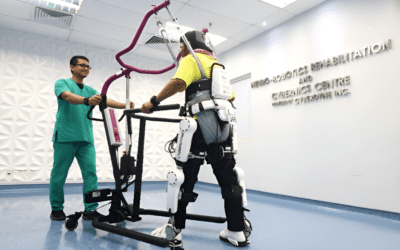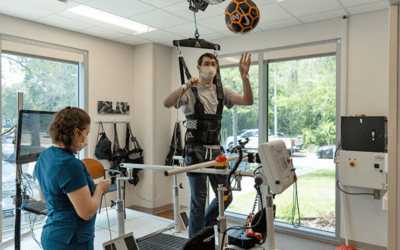Cyberdyne treatment, a definite outcome based on New Age Technology
Cyberdyne treatment is an innovative medical technology that uses the HAL exoskeleton to improve a patient’s walking ability. HAL detects bioelectric signals between the brain and skin surface above the muscles and converts them into muscle movement.
The power unit can be controlled in real time to assist joint movement by reading signals with the device. Clinical applications have reported HAL’s positive impact on promoting the body’s natural healing ability. HAL Robo Suits have demonstrated promising outcomes in patients who have suffered from stroke or paralysis.
In the healthcare industry, keeping up with new and advanced technology is crucial. Cyberdyne treatment is a prestigious addition to Nueuro Rehabiliation.

HAL is the starting point for the mobility journey and is used to treat spinal cord injuries. HAL exoskeleton detects bioelectric signals from the brain and converts them into muscle movement, promoting natural healing.
HAL is an advanced robotic treatment device proven to improve a patient’s ability to walk. It works by reading the nerve signals that are transmitted from the brain to the muscles through motor neurons, which causes the musculoskeletal system to move.
HAL can interpret signals and assist joint movement with the person.This creates interactive biofeedback between HAL, the brain, the nervous system, and the muscular system. Clinical studies have shown that this treatment method is effective in promoting functions of the lower limb, upper limb, and body trunk.
The functional regeneration technology used by HAL activates the body’s self-healing ability, which humans naturally possess, and improves brain-nerve-musculoskeletal functions. Before a patient can be dressed in the HAL, a certain condition must be fulfilled.
The Hybrid Assistive Limb (HAL) requires the patient’s nerves connecting the legs to the brain to be partially functional and generate enough electrical signals.
However, the HAL does not need the patient to perform all the work; it only requires a percentage of the effort. From there, the HAL can interpret the patient’s intentions to produce the desired results.”
Here are the five steps that HAL follows while treating a patient:

1. Anticipate – The brain at first, generates command signals.
2. Send Signals – The muscles receive the command.
3. Read the Signals – HAL sensors detect bio-electrical signals and recognize the wearer’s intended movement.
4. Movement – HAL moves as the wearer intends.
5. Response – Information is sent back to the brain.
The HAL Robo Suits have a positive impact on patients who suffer from stroke and paralysis.
These are the first wearable robotic suits. They interpret the signals from the brain and nerves to enhance body movements.
During this process, a weak bioelectric potential signal escapes to the HAL. The HAL detects the wearer’s possible signal leaks through a sensor attached to the skin and carries out the intended action accordingly.
“Since using Cyberdyne, I feel more mobile than ever before. Today marks my last day walking with the Cyberdyne Hall at Brooks Rehabilitation. I have made significant clinical improvements compared to when I first started. Thanks to this technology, I now have more confidence to be on my feet and be more physically active.”
To learn more about Cyberdyne treatment, connect with us at info@rehabmodalities.com.



